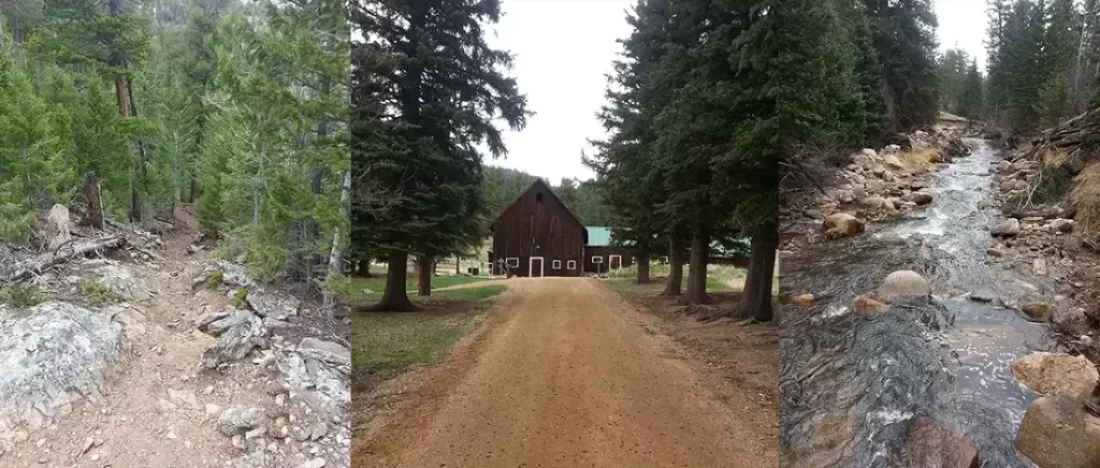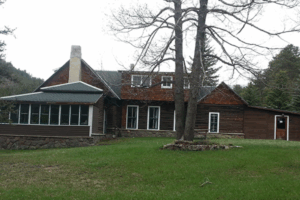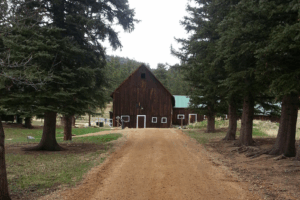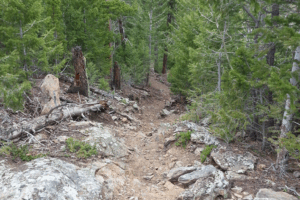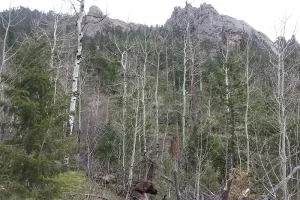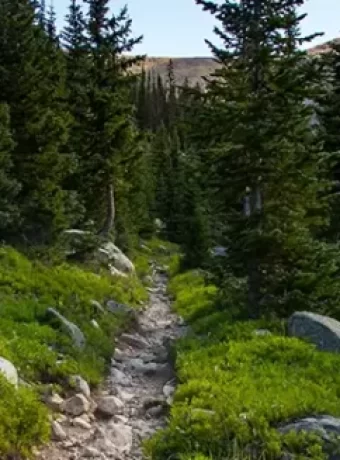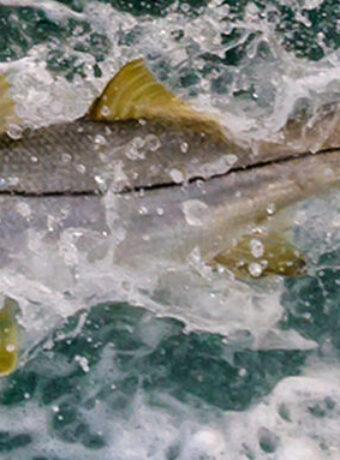West Creek Falls Hike from McGraw Ranch in Rocky Mountain National Park
Imagine standing at the edge of a cascading waterfall, the mist cooling your face as you take in the breathtaking views of Rocky Mountain National Park. This is the reward that awaits you at West Creek Falls, a hidden gem accessible via a delightful hike from McGraw Ranch.
For anglers, West Creek itself offers exciting fly fishing opportunities, complemented by nearby alpine lakes in the Comanche Peak Wilderness Area and Rocky Mountain National Park. In this comprehensive guide, we’ll walk you through everything you need to know to plan an unforgettable adventure, including a detailed hike to West Creek Falls, fly fishing tips for West Creek, and the best nearby lakes for fishing.
Table of Contents
Introduction to the West Creek Falls Hike
Rocky Mountain National Park is a paradise for outdoor enthusiasts, boasting rugged peaks, alpine lakes, and a vast network of trails. Among its many offerings, the hike to West Creek Falls from McGraw Ranch stands out as an ideal day hike for those seeking a mix of adventure, scenery, and tranquility.
This 4.7-mile round trip trail takes you through diverse landscapes—lush meadows, dense forests, and a dramatic canyon—before culminating at the stunning West Creek Falls.
What makes this hike special is its accessibility and the sheer joy it
brings. With a moderate difficulty level and an elevation gain of about 1,500 feet, it’s challenging enough to feel rewarding yet manageable for hikers of various skill levels. Whether you’re a solo trekker, a family with kids, or a photography buff, this trail promises a fun day filled with natural wonders and memorable moments.
In this article, we’ll dive into the history of McGraw Ranch, provide a
step-by-step guide to the hike, highlight what makes it enjoyable, offer practical tips, and share personal stories from fellow hikers. By the end, you’ll be ready to lace up your boots and explore one of Colorado’s best day hikes.
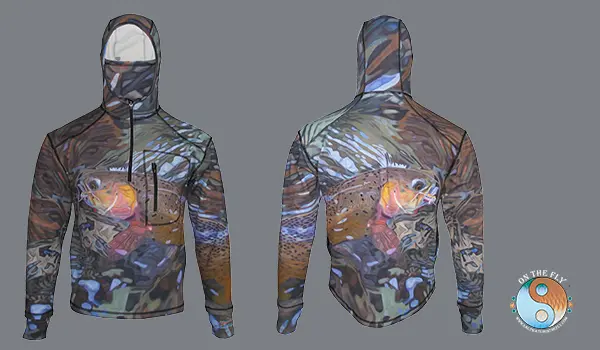
- McGraw Ranch House
- Hiking down driveway on McGraw Ranch, Rocky Mountain National Park
Colorado has a lot to offer, but really the Rocky Mountain West is very unique it in it’s topography. I love fly fishing, hiking, and exploring all the ghost towns from the Mexican border to the North Coast of this Mountain Range. Montana has a rich history worth exploring. Colorado’s mining history has left the mountains and prairie doted with ghost towns, for you to explore.
Historical Charm of McGraw Ranch
Before embarking on the trail, it’s worth understanding the historical significance of McGraw Ranch, the starting point of your journey. Located in the northeastern corner of Rocky Mountain National Park, this site is more than just a trailhead—it’s a window into the past.
McGraw Ranch was first established in 1884 by Peter J. Pauley, Jr. as a 160-acre homestead. Over time, it grew to 1,160 acres and changed ownership, eventually landing in the hands of John and Irene McGraw in 1909. Initially a working ranch, it was transformed into a dude ranch in 1936, welcoming visitors eager to experience the Wild West. Guests enjoyed horseback riding, fishing, and hiking until the ranch ceased operations in 1979.
In 1988, the National Park Service acquired the property, recognizing its cultural value. A restoration project began in 1999, preserving original structures from the 1880s and 1930s. Today, McGraw Ranch serves as a research facility, but its grounds remain open to the public, offering access to trails like the one to West Creek Falls.
Walking through the ranch, you’ll see rustic cabins, barns, and the main house, each telling a story of early settlers and ranching life. Interpretive signs provide context, making it a fascinating stop before or after your hike. This historical backdrop adds a unique layer to your adventure, connecting you to the legacy of Rocky Mountain National Park.
Hike to West Creek Falls: A Step-by-Step Journey
The hike to West Creek Falls is a 4.7-mile round trip that begins at the Cow Creek Trailhead, accessible via McGraw Ranch Road. To get there from Estes Park, take MacGregor Avenue north (which becomes Devils Gulch Road) for 3.4 miles, then turn left onto McGraw Ranch Road and follow it 2.1 miles to the parking area. The gravel road is suitable for most vehicles, but parking is limited to about 12 spaces, so arrive early—especially on weekends.
Starting at the Trailhead
Your adventure begins at the Cow Creek Trailhead, just past the historic
McGraw Ranch buildings. The trail starts along an old gravel road, offering a
gentle introduction as you pass the ranch’s preserved structures. The air is
crisp, filled with the scent of pine and the faint sound of Cow Creek in the
distance. Within 0.1 miles, you’ll reach a junction where the North Boundary
Trail splits to the right—this is your path to West Creek Falls.
Through the Meadows and Forests
The first stretch of the trail winds through open meadows, where wildflowers
bloom in vibrant hues during spring and summer. The scenery is
postcard-perfect, with the Mummy Range looming in the distance. As you
progress, the trail enters a mixed forest of ponderosa pine, aspen, and spruce.
The canopy provides shade, and the forest floor is a soft carpet of pine
needles and leaves.
At around 0.8 miles, the trail steepens, ascending a tapered gulch. This
section is where the moderate difficulty kicks in, with an incline that gets
your heart pumping. Take it slow and enjoy the emerging views of the
surrounding peaks. Wildlife is abundant here—mule deer often graze nearby, and
you might spot a fox or hear the chirping of chickadees.
Reaching the Ridge
After about 1.0 mile, you’ll crest a ridge at 8,457 feet—the highest point
of the hike. Pause here to catch your breath and soak in the panoramic vistas.
On a clear day, the rugged mountains stretch endlessly before you, a testament
to the wild beauty of the park. This is a prime spot for photos or a quick
snack break.
From the ridge, the trail descends into the West Creek drainage. The descent
starts gradually but grows steeper, with the sound of rushing water growing
louder. The path narrows in places, requiring careful footing on loose gravel
or roots.
- Ridge on trail to West Creek Falls Hike
- Starting down from the Ridge in Comanche Peaks Wilderness towards West Creek Falls.
- Peaks from the ridge, was a very over cast morning on West Creek Falls Hike.
Arriving at the Falls
At 1.9 miles, you’ll re-enter Rocky Mountain National Park, marked by a sign. The trail becomes more rugged, with some erosion and tight sections—watch your step, especially if it’s wet. Finally, at 2.2 miles, you’ll reach West Creek Falls. The two-tiered cascade drops 15-20 feet over smooth granite into clear pools below, framed by a shaded canyon. The sight is mesmerizing, and the cool mist from the falls is a refreshing reward.
Spend some time here—sit on a boulder, dip your toes in the water (if safe), or snap photos of the cascading beauty. The area around the falls invites exploration, though the rocks can be slippery, so proceed with caution.
The Return Journey
After enjoying the falls, retrace your steps back to the trailhead. The return offers a fresh perspective, with downhill sections easing the effort and new angles on the scenery. As you pass through the meadows again, reflect on the journey and the natural wonders you’ve experienced. The round trip takes about 3-5 hours, depending on your pace and stops.
Whoa! Stop Right There! Fly Fishing West Creek: Trout, Flies, and Techniques
West Creek, flowing through the canyon near the falls, is a delightful small stream for fly fishing, offering a chance to catch trout in a pristine setting. Its clear waters, rocky pools, and undercut banks create ideal habitats for trout, making it a perfect add-on to your hike.
Trout Species in West Creek
· Brook Trout: The most common species, thriving in the creek’s cold, oxygenated waters. These colorful fish (4-10 inches) are aggressive feeders, ideal for beginners.
· Greenback Cutthroat Trout: A native species and Colorado’s state fish, occasionally found in West Creek. They’re selective but rewarding, typically 6-12 inches.
· Brown Trout: Less common but present in deeper pools, especially downstream. These cunning fish (8-14 inches) require stealth.
Recommended Fly Patterns
· Dry Flies:
o Parachute Adams (#16-18): A versatile pattern mimicking midges and mayflies, perfect for brook and cutthroat trout in riffles.
o Elk Hair Caddis (#14-16, tan or olive): Excels during evening caddis hatches, enticing surface strikes.
o Royal Wulff (#14-16): Its bright colors attract aggressive brook trout in faster water.
· Nymphs:
o Pheasant Tail Nymph (#16-20): Imitates small mayfly nymphs, effective in deeper pools for all species. Soft hackle version of a pheasant tail works very well, the soft hackle fibers present more movement.
o Zebra Midge (#18-22, black or red): A go-to for subsurface feeding, especially in slower sections.
o Hare’s Ear Nymph (#16-18): A natural-looking fly for brown trout in undercut banks.
· Streamers:
o Woolly Bugger (#10-12, olive or black): Great for targeting larger brown trout in deep pools with a slow retrieve. Woolly Bugger is a favorite for fly fishing pools and tailouts.
o Muddler Minnow (#12-14): Mimics small baitfish, effective in faster currents.
How to Catch Trout in West Creek
· Tactics:
o Dry Fly Fishing:
Focus on riffles and pool heads where trout rise for insects. Cast upstream, let the fly drift naturally, and mend the line to avoid drag. Early morning or late afternoon is best for surface activity.
o Nymphing:
Use a small indicator or tight-line nymphing in deeper pools and undercuts. Add a split shot 6-8 inches above the fly for depth. Short, precise casts work in tight spaces.
o Streamers:
Strip streamers slowly through deeper pools or along banks to provoke strikes from brown trout. Use a sinking tippet (5X) for better control.
· Approach: West Creek’s clear water demands stealth. Approach from downstream, stay low, and avoid casting shadows. Wear muted clothing to blend in.
· Gear: A 3-4 weight rod (7.5-8.5 feet) is ideal for tight casts. Use 5X-6X tippet for wary trout, and carry a small fly box with the patterns above.
· Timing: June to September offers peak fishing, with July-August seeing strong hatches. Spring runoff (May-early June) can muddy waters, so target late summer or early fall for clarity.
Tips for Success Fly Fishing West Creek
· Fish near the falls’ base or downstream pools where trout congregate. Look for foam lines or shaded areas.
· Keep casts short (10-20 feet) to navigate overhanging branches.
· Practice catch-and-release to preserve the fishery, using barbless hooks and minimizing handling.
· Check Colorado Parks and Wildlife regulations—a fishing license is required, and some areas may have restrictions.
Fly Fishing West Creek adds an exhilarating dimension to your hike, letting you cast in a serene canyon setting just steps from the falls.
Learn more about Fly Fishing the Comanche Peaks Wilderness Area and Fly Fishing Colorado.
What Makes This Hike Fun
The West Creek Falls hike is a delight for many reasons, blending physical challenge with sensory pleasures. Here’s what makes it a standout day hike in Rocky Mountain National Park:
Scenic Diversity
The trail’s variety keeps you engaged from start to finish. You’ll transition from open meadows to shaded forests and end in a dramatic canyon, each segment offering its own charm. Wildflowers, towering trees, and rugged cliffs provide endless visual treats, perfect for nature lovers and photographers alike.
Wildlife Encounters
This hike is a haven for wildlife spotting. Early mornings or late afternoons are ideal for seeing elk in the meadows or deer in the forests. Birdwatchers can look for American dippers bobbing along the creek or bald eagles soaring above. These encounters add an element of excitement and connection to the natural world.
The West Creek Falls Experience
West Creek Falls is the star of the show, especially in spring and early summer when snowmelt boosts its flow. The two-tiered drop is both powerful and serene, with mist rising from the pools below. It’s a perfect spot to relax, eat a picnic, or capture stunning photos—morning light enhances the water’s sparkle, making it a photographer’s dream.
Historical Connection
Starting at McGraw Ranch ties the hike to a rich past. Walking where settlers and dude ranch guests once roamed adds a storytelling element to the physical journey. It’s a chance to appreciate how this land has evolved while remaining a sanctuary for adventure.
Peaceful Solitude
Unlike busier trails in the park, this route offers relative quiet. You’re more likely to hear the rustle of leaves or the creek’s murmur than crowds of voices, making it an ideal escape for those seeking tranquility.
Practical Information for a Successful Hike
Preparation ensures a safe and fun day on the trail. Here’s what you need to know:
What to Pack in Pack & Wear
· Clothing: Layer up with a moisture-wicking base, insulating mid-layer, and waterproof jacket. A hat and sunglasses protect against sun.
· Footwear: Wear sturdy hiking boots with ankle support; trekking poles help on steep sections.
· Hydration: Carry at least 2 liters of water per person—more in heat. Use a hydration bladder or bottles.
· Food: Pack snacks like trail mix or energy bars, plus a light lunch for the falls.
· Navigation: Bring a map (e.g., National Geographic Trails Illustrated) or GPS, though the trail is well-marked.
· Safety Gear: Include a first-aid kit, whistle, multi-tool, and headlamp. Bear spray is wise for wildlife encounters.
· Leave No Trace: Pack out all trash and stick to the trail to preserve the ecosystem.
Best Time to Hike to West Creek Falls
Late spring to early fall (June-September) is ideal, with warm weather and minimal snow. Spring brings wildflowers and fuller falls, while fall offers golden aspens. Afternoon thunderstorms are common, so start early. Winter hiking is possible but requires snow gear and experience.
Safety Tips
· Tell Someone: Share your plans and return time with a friend.
· Stay on Trail: Protects nature and prevents getting lost.
· Weather Check: Mountain conditions shift fast—monitor forecasts.
· Wildlife: Make noise to avoid surprising animals; carry bear spray and give space.
